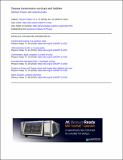Disease transmission via drops and bubbles
Author(s)
Poulain, Stephane; Bourouiba, Lydia
DownloadPublished version (295.5Kb)
Publisher Policy
Publisher Policy
Article is made available in accordance with the publisher's policy and may be subject to US copyright law. Please refer to the publisher's site for terms of use.
Terms of use
Metadata
Show full item recordAbstract
Seasonal influenza was responsible for nearly a million hospitalizations in the US in 2018, and tuberculosis killed more than a million people around the world. Those and other infectious diseases are spread by pathogens, such as bacteria and viruses. An important part of the pathogens' life cycle occurs in liquids, whose fluid dynamics influences transmission from one infected host or environmental reservoir to another. A cough or sneeze, for instance, produces a turbulent cloud of hot, moist air and droplets, as shown in figure 1. That cloud and its droplet payload can span a room up to 8 m long in a few seconds. Droplets can also be spread from bursting bubbles or splashed from a wet, contaminated surface. To predict and model disease transmission at both population and individual scales, and to develop efficient mitigation innovations and strategies against the spread of infectious diseases, understanding the role of the underlying fluid dynamics is critical. Yet little is known about the factors affecting the source, transport, and persistence of pathogen-bearing droplets. This Quick Study focuses on the example of bursting air bubbles to illustrate the rich physics and close coupling of biology and fluid dynamics in the context of disease transmission.
Date issued
2019-05Department
Massachusetts Institute of Technology. Department of Civil and Environmental Engineering; Massachusetts Institute of Technology. Fluid Dynamics of Disease Transmission LaboratoryJournal
Physics Today
Publisher
AIP Publishing
Citation
Poulain, Stephane and Lydia Bourouiba."Disease transmission via drops and bubbles." Physics Today 72, 5 (May 2019): 70 © 2019 American Institute of Physics
Version: Final published version
ISSN
0031-9228
1945-0699